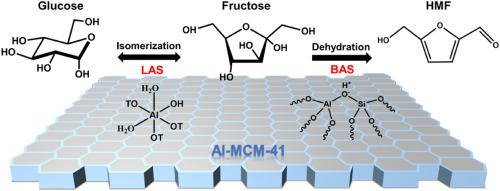Ultrasonic-assisted synthesis of acidic Al-MCM-41 for enhanced selective production of HMF from glucose
IF 7.9
3区 材料科学
Q1 GREEN & SUSTAINABLE SCIENCE & TECHNOLOGY
引用次数: 0
Abstract
The sustainable transformation of renewable biomass into value-added chemicals is essential to addressing global environmental and energy challenges. Among these, the production of 5-hydroxymethylfurfural (HMF) from biomass-derived glucose is of considerable interest for both scientific and industrial applications. In this study, mesoporous aluminium incorporated MCM-41 catalysts (Al-MCM-41) were synthesized using an ultrasonic-assisted method at room temperature. Their ordered mesoporous structure was preserved even with high concentrations of Al. The catalysts' acidity was finely tuned by varying the Si/Al ratio, enabling the development of an optimal catalyst to enhance the glucose-to-HMF conversion via Brønsted and Lewis acid catalysis. Characterization techniques, including XRD, TEM, N2 adsorption-desorption, NH3-TPD, Py-FTIR, 29Si and 27Al MAS NMR, were employed to evaluate the catalysts’ structure and acidity. The results revealed that ultrasonic-assisted synthesis strategy improves Al dispersion, optimizes acid site density, and significantly enhances HMF yield and selectivity. The best-performing Al-MCM-41-10 catalyst can afford ∼90 % glucose conversion with ∼60 % HMF selectivity at 160 °C, and displays excellent reusability under the applied reaction conditions. This study provides valuable insights into designing efficient catalysts for biomass conversion and underscores the broad applicability of the ultrasonic-assisted synthesis method for other heteroatom-doped mesoporous materials, such as Sn-MCM-41.

超声辅助合成酸性Al-MCM-41增强葡萄糖选择性生产HMF
将可再生生物质可持续地转化为增值化学品对于应对全球环境和能源挑战至关重要。其中,从生物质来源的葡萄糖生产5-羟甲基糠醛(HMF)在科学和工业应用方面都具有相当大的兴趣。本研究采用超声辅助法制备了介孔铝掺杂MCM-41催化剂(Al-MCM-41)。它们的有序介孔结构即使在高浓度的Al中也能保持不变。通过改变Si/Al的比例,可以很好地调节催化剂的酸度,从而开发出一种最佳催化剂,通过Brønsted和Lewis酸催化提高葡萄糖到hmf的转化。采用XRD、TEM、N2吸附-脱附、NH3-TPD、Py-FTIR、29Si和27Al MAS NMR等表征技术对催化剂的结构和酸度进行了表征。结果表明,超声辅助合成策略改善了Al的分散,优化了酸位密度,显著提高了HMF的收率和选择性。性能最好的Al-MCM-41-10催化剂在160℃条件下可实现~ 90%的葡萄糖转化率和~ 60%的HMF选择性,并且在应用的反应条件下具有良好的可重复使用性。该研究为设计高效的生物质转化催化剂提供了有价值的见解,并强调了超声波辅助合成方法在其他杂原子掺杂介孔材料(如Sn-MCM-41)中的广泛适用性。
本文章由计算机程序翻译,如有差异,请以英文原文为准。
求助全文
约1分钟内获得全文
求助全文
来源期刊

Materials Today Sustainability
Multiple-
CiteScore
5.80
自引率
6.40%
发文量
174
审稿时长
32 days
期刊介绍:
Materials Today Sustainability is a multi-disciplinary journal covering all aspects of sustainability through materials science.
With a rapidly increasing population with growing demands, materials science has emerged as a critical discipline toward protecting of the environment and ensuring the long term survival of future generations.
 求助内容:
求助内容: 应助结果提醒方式:
应助结果提醒方式:


